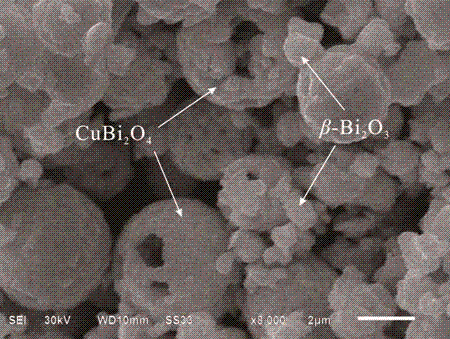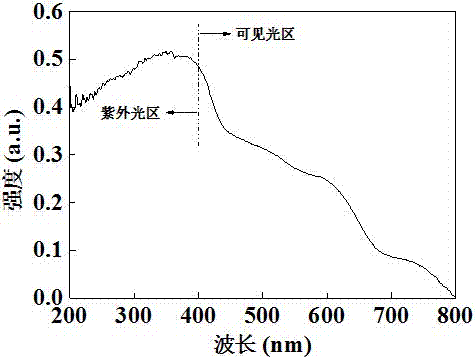Visible light responsive composite photocatalyst, preparation method and applications thereof
A responsive, composite light technology, applied in the field of photocatalysis, can solve the problems of poor photocatalytic activity, low quantum efficiency of photocatalytic system, affecting photocatalytic efficiency, etc., to achieve good photocatalytic performance, high visible light absorption intensity, and recycling. high rate effect
- Summary
- Abstract
- Description
- Claims
- Application Information
AI Technical Summary
Problems solved by technology
Method used
Image
Examples
Embodiment 1
[0051] Preparation of visible light responsive composite photocatalyst:
[0052] (1) First, CuBi with uniform morphology and structure was prepared by hydrothermal method 2 o 4 , that is, 0.04 mole parts of Bi(NO 3 ) 3 ·5H 2 O dissolved in 3 mL concentrated HNO 3 , stirred to dissolve completely, and then added 20 mL of 0.02 molar parts of Cu(NO 3 ) 2 ·3H 2 O, stir to make it evenly mixed, then dropwise add 20 mL of 1.2 mol / L NaOH, and dilute the dropwise mixed solution to 70 mL, continue stirring for 1 h, then transfer the mixed solution to a high-pressure reactor , raised the temperature to 100 °C, and reacted for 24 h. After the reaction kettle was naturally cooled to room temperature, the precipitate obtained from the reaction was repeatedly ultrasonically washed with ultrapure water, and centrifuged at 6000 r / min, and then separated at 60 ℃ in a vacuum drying oven for 12 h, ground and passed through an 80-mesh sieve to obtain CuBi 2 o 4 .
[0053] (2), and then...
Embodiment 2
[0057] The preparation of the visible light-responsive composite photocatalyst was the same as in Example 1.
[0058] The performance test of the visible light-responsive composite photocatalyst applied to the removal of diclofenac in water: 0.2 g of the above-mentioned visible light-responsive composite photocatalyst was added to 1 L of 5 mg / L diclofenac solution, and the dark adsorption reaction was carried out for 30 minutes to reach the adsorption equilibrium. Then, the photocatalytic reaction was performed under 300 W xenon lamp irradiation for 3 h. After the experiment, the solid and liquid were separated by centrifugation, and the residual concentration of diclofenac in the supernatant was determined. It can be seen from the test results that the removal efficiency of diclofenac by the visible light-responsive composite photocatalyst is 80.49%.
Embodiment 3
[0060] The preparation of the visible light-responsive composite photocatalyst was the same as in Example 1, except that the volume of gluconic acid in the gluconic acid solution was 0.6 mL.
[0061] The performance test of the visible light-responsive composite photocatalyst applied to the removal of diclofenac in water: In 1 L of 5 mg / L diclofenac solution, 0.4 g of the above-mentioned visible light-responsive composite photocatalyst was added, and the dark adsorption reaction was carried out for 30 minutes to reach the adsorption equilibrium. Then, the photocatalytic reaction was performed under 300 W xenon lamp irradiation for 3 h. After the experiment, the solid and liquid were separated by centrifugation, and the residual concentration of diclofenac in the supernatant was determined. It can be seen from the test results that the removal efficiency of diclofenac by the visible light-responsive composite photocatalyst is 78.62%.
PUM
 Login to View More
Login to View More Abstract
Description
Claims
Application Information
 Login to View More
Login to View More - R&D
- Intellectual Property
- Life Sciences
- Materials
- Tech Scout
- Unparalleled Data Quality
- Higher Quality Content
- 60% Fewer Hallucinations
Browse by: Latest US Patents, China's latest patents, Technical Efficacy Thesaurus, Application Domain, Technology Topic, Popular Technical Reports.
© 2025 PatSnap. All rights reserved.Legal|Privacy policy|Modern Slavery Act Transparency Statement|Sitemap|About US| Contact US: help@patsnap.com



